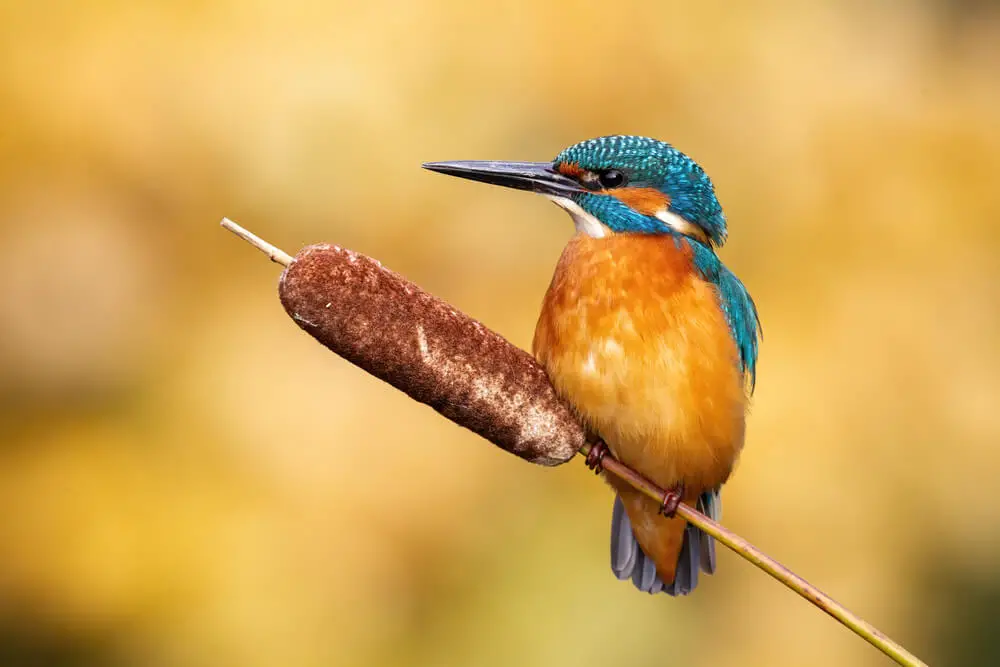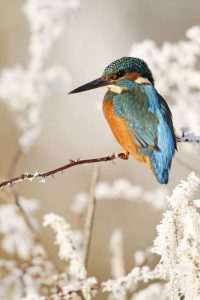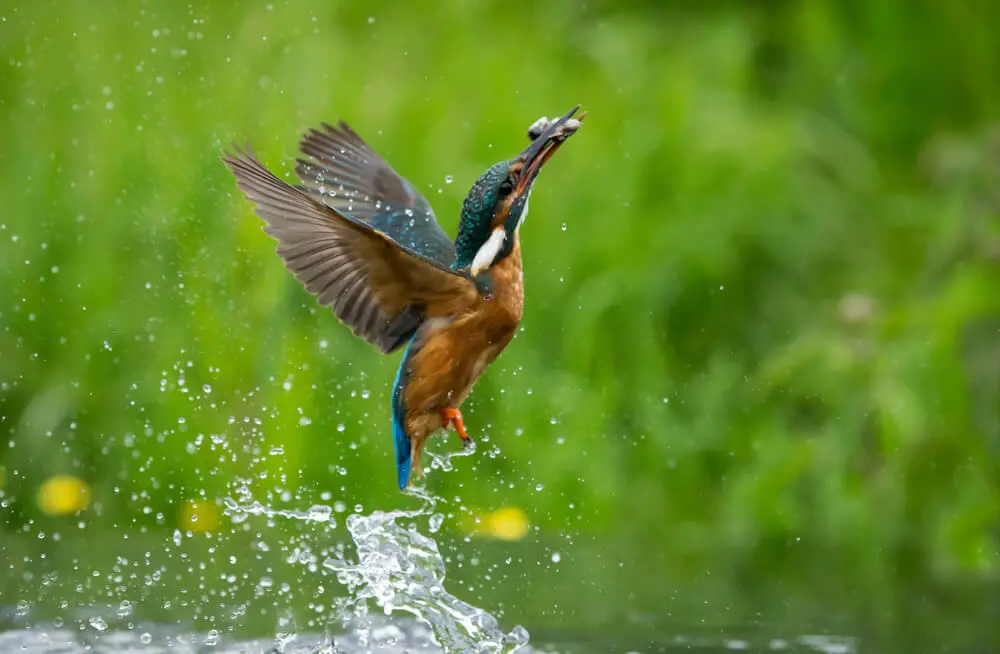There are few birds with more striking plumage than the kingfisher. Their colourful feathers are easily identifiable, and so a visit from one would stick in your memory.
I haven’t been lucky enough to have a kingfisher visitor, but I think I know why.
They are widespread birds across Britain but most prevalent in central and southern England. Their natural habitat is near still or slow-flowing water such as streams, lakes, pools, and canals. Their primary food is fish, but supplement their diet with aquatic insects and tadpoles.

If you’re going to try to attract kingfishers to your garden, it is very likely going to involve water.
It is possible to attract most birds to visit your garden with the temptation of abundant food and/or somewhere safe to construct their nest.
The kingfisher is no exception to the rule although, it takes a little more effort than adding a few sunflower hearts to the table.
You have a head start if your garden is rural or suburban and close to open water. You will fair better still with a pond or pool and a ready stock of minnows and other small fish for the kingfisher to dine on.
Other ways to attract kingfishers include providing somewhere for them to build their tunnel style nest or fitting a designated kingfisher nesting box. It could be as simple as offering them some raw meat on a table in the open.
Table of Contents
How to Attract Kingfishers to your Garden with Water
If you’re going to spend time, effort, and money building a pool for kingfishers, be aware they will eat your fish!
An expensive, ornamental Koi carp pond might impress the neighbours but, also encourage passing kingfishers to swoop in and spear your fish with his long, sharp beak.
Set up a pond
A plastic tub is enough if you don’t want to go to the expense of a fibreglass pool mould. It should be at least 120cm x 60cm and 45cm deep; this is the minimum size to maintain a stable temperature and sufficient oxygen.
You don’t need to sink it in the ground; resting it on level ground is fine.
Considerations
- Kingfishers dive up to 1m, so you can afford to make the pool a little deeper.
- Fibreglass lasts forever but is expensive; plastic is cheap but degrades over time.
- Floating plants are quick and easy to add. They give interest to the pond and help to oxygenate the water.
Where to position the pond
In the wild, kingfishers hunt in clearings. They prefer open spaces where they assess the best viewing posts while remaining safe from predation.
Choose a spot that is as open as possible; heavy planting obscures the bird’s view and drives them away. A site with few shrubs and little vegetation is best, although it needs some to stop the pond from looking like a tub of water.
A random tree provides the ideal lookout post for a hungry kingfisher.

Somewhere to perch
Kingfishers are very patient birds and will sit quietly for an age, just observing the water, waiting for their time to strike.
They like somewhere sturdy to perch, branches work, at the ideal height of 2m above the water. Other options;
- Stacks of rocks
- Washing line post
- Fencing stumps
- Trellising
Stocking the pond
Pet shops sell fish specifically bred as food for carnivorous birds and fish. Some aquatic stores sell rejects and runts at greatly reduced prices and often in bulk.
Kingfishers prefer fish less than an inch long but will eat larger ones. Platys are perfect; they reproduce very quickly and swim close to the surface, even when they’ve just seen a bird steal one of their friends!
Considerations
- Colourful fish attract passing kingfishers best.
- Occasionally offer different food, a biodiverse habitat is more attractive and beneficial to birds.
- Snails, crayfish, frogs, and tadpoles are tasty options.
- Choose fish that are self-sustainable and hardy; that way they require less maintenance, you won’t need to restock so often.
- Don’t overcrowd the pond; it affects the oxygen levels.
Maintenance
Keep the pond clean and feed the fish daily to keep them healthy. Kingfishers regularly return to sites where they find an abundant stock of tasty food.
If you’re still unsure, there is always someone on hand at the local aquatic store or per shop to offer advice.
How to attract kingfishers with nesting sites
The kingfisher builds a nest that is unlike most other birds; it is a tunnel.
They channel out muddy riverbanks, burrowing deep enough to create a secure, hidden chamber. Construction takes them around a week to complete.
To recreate a similar habitat, you need to clear a sloped space at the edge of a large, ground-level pool or lake. It has to be free of all vegetation as the roots obstruct the bird’s path.
Kingfishers tunnel 1-2m into the bank, so you should have plenty of available space.
Nesting boxes
There are dedicated nesting boxes for kingfishers; they are ideal for gardens with rivers, streams, or lakes.
Bury the box in a vertical bank, with the entrance showing. The tunnel should slope downwards to allow for drainage; the doorway should be the only visible part.
Kingfishers use the chamber structures as long as the entrance hole is 1m above the highest water level.
How to attract kingfishers to the garden with food
Hungry kingfishers are always on the lookout for food, but never more so than in a harsh winter. If there are no fish available, they may be tempted to a feeding table.
They will only visit if the table is in the open and they’re ravenous.
Provide small pieces of offal to entice them, bits of raw meat, and if hungry enough, they might eat bread, although it has little nutritional value.
Offer fresh drinking water close by to increase the chances of a visiting kingfisher.
Stay Quiet
Kingfishers love peace and tranquillity; their keen senses pick up movement in the water below or incoming predators.
They are suspicious birds and wary of everything, including humans.
They won’t land where there are noisy pets; if dogs have free-roam of the garden, it is unlikely that kingfishers will visit.
If you can move them to a different area or keep them indoors for periods of the day, your chances of seeing this striking creature increase.

Where to watch kingfishers from
The best place to watch the kingfishers is from a purpose-built hide.
This doesn’t need to be an expensive structure; it might just be some well-placed branches or a wooden framework with a piece of neutral-coloured fabric draped over it.
Remember to stay at a distance, be very quiet, and just like the kingfisher, be patient.
Final thoughts
Everyone can’t attract kingfishers to their garden; instead, it isn’t too difficult to go out and find them.
The best way is to follow the fish! Pitch a comfy chair near the banks of your nearest river, and wait; it shouldn’t be too long before you spot this spectacular bird.
Whether you’re in your garden or out and about, the best piece of information I can impart is – don’t forget your camera!
